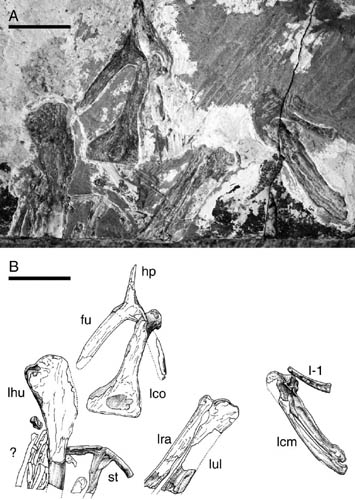| Location: Home > Research > Research Progress |
| New Finding Further Reduces Morphological Gap Between Two Major Avian Groups |
|
During the 2005 field season, Paleontologists from Institute of Vertebrate Paleontology and Paleoanthropology (IVPP), Chinese Academy of Sciences, and Paleontological Institute of Shenyang Normal University, collected a partial postcranial skeleton of a new enantiornithine bird from the Lower Cretaceous Jiufotang Formation at the Dapingfang Locality, Chaoyang County, western Liaoning, China, and described it to a new enantiornithine bird, Xiangornis shenmi, gen. et sp. nov., which exhibits some features normally present in derived ornithurines, further blurring the distinctness of the two major avian groups.
This new find indicates that a carpometacarpal morphology similar to that seen in modern birds probably evolved independently in enantiornithines and appeared earlier than in Ornithuromorpha, and demonstrates that character evolution in early birds was more complex than previously believed. Researchers reported in the latest issue of Journal of Vertebrate Paleontology 32(3), May 2012. Enantiornithes and Ornithuromorpha represent two major avian radiations. Enantiornithes is restricted to the Cretaceous, whereas Ornithuromorpha is the sister taxon to Enantiornithes and includes all living birds. The two groups were previously considered to differ in many aspects of their skeletal anatomy. However, new discoveries of basal birds, particularly some recent finds from the Lower Cretaceous Jehol Group of Liaoning Province, China, have substantially reduced this morphological gap. The partial postcranial skeleton includes nearly complete furcula, left coracoid, left carpometacarpus, and first phalanx of the left alular digit; partial sternum, and left humerus, ulna, and radius. Xiangornis shenmi has several enantiornithine features, including a furcula with a significantly elongated hypocleidium, a coracoid with a convex lateral margin, and a minor metacarpal that extends further distally than the major metacarpal. However, it also possesses some derived ornithurine features, such as a short alular metacarpal (about one-sixth as long as the major metacarpal) that is completely fused to the major metacarpal, a large extensor process on the alular metacarpal, proximal and distal fusion between the minor and major metacarpals, and an intermetacarpal space positioned significantly distal to the alular metacarpal. “The discovery of Xiangornis suggests that a derived, ornithurine-type carpometacarpus evolved independently within Enantiornithines, and in fact appeared earlier in this group than in Ornithuromorpha”, said study corresponding author XU Xing, a distinguished professor of the IVPP, “The large extensor process and distal fusion between the major and minor metacarpals both seem to relate, in different ways, to stabilization of the distal wing during flight, implying that Xiangornis was converging on ornithurine birds in some functionally significant aspects of its wing structure”. This study was supported by the National Natural Science Foundation of China, Natural Science Foundation of Liaoning Province, and Scientific Research Fund of Education Bureau of Liaoning Province.  Fig.1 Holotype specimen of Xiangornis shenmi, gen. et sp. nov. (PMOL-AB00245). A, photograph; B, line drawing. Scale bars equal 20 mm. (Image by XU Xing) |